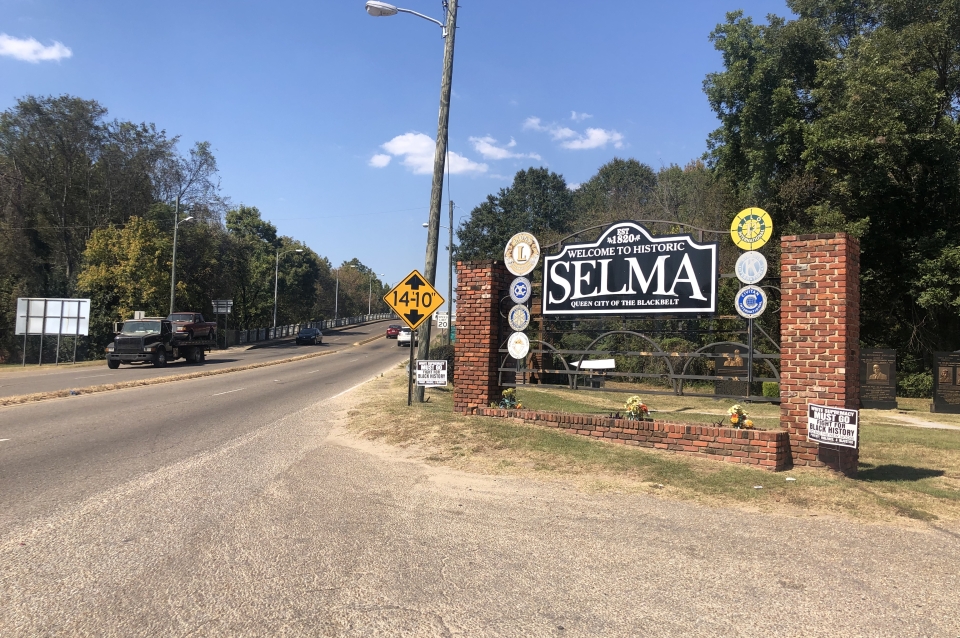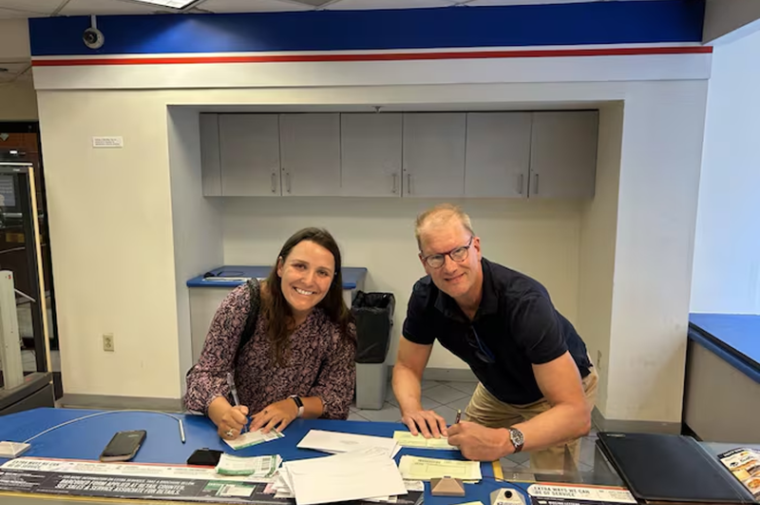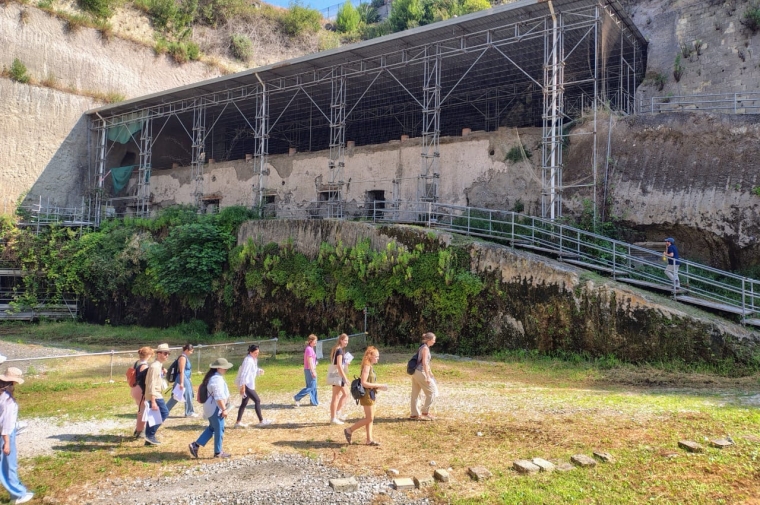November 3, 2022
Stuart Weitzman School of Design
102 Meyerson Hall
210 South 34th Street
Philadelphia, PA 19104
Get the latest Weitzman news in your Inbox
Areas
Cyrus Yerxa (MSHP '23) is a student in Randall Mason's studio group focused on downtown Selma, Alabama. Here, he writes at the midpoint of the semester about the group's research thus far, and their trip to Selma during Weitzman studio travel week.
Traveling west on U.S. Route 80 across the Edmund Pettus Bridge and into Selma, Alabama, one encounters Water Avenue’s brick buildings perched in a row above the bluffs of the Alabama River. Going straight through the 1970s-era suspended street-light (which you can hear audibly changing) takes you up Broad Street past a remarkably continuous stretch of 19th and early 20th century mixed-use buildings, once the commercial core of a gridded 4x4-block downtown. At the intersection of Broad and Water, a 3-story former bank built in the 1870s now houses the National Parks Service’s Selma Interpretive Center. Continuing north past Alabama Street, the neon sign of Pilcher and Mcbryde’s Rexall Drugs is mounted proudly in front of the Italianate arched windows of the large corner pharmacy. Further up, near Dallas and Broad, the old YMCA building – “1886, First in the South & Oldest Still Standing” reads a sign on the door – sits vacant but solid, monumental. On the plywood over the first-floor windows, a local artist has painted scenes of Selma storefronts past.
Just up Franklin Street, parallel to Broad and flanking downtown to the east, the 114-year-old symmetrical belltowers of the iconic Brown Chapel AME rise above the scaffolding being used to rehabilitate the building. The Chapel sits squarely in the middle of the roughly fifty mid-century gable-ended brick houses that make up the George Washington Carver Homes. Freshly mowed grass fills the ample space between buildings, and people fill the grass. The sounds and smells of a barbecue waft from the houses just north of the Chapel. Back on Water Street, the sun begins to set over the Alabama.
This was the scene for the first afternoon of our Historic Preservation Studio trip to Selma in early October. We were there to investigate how preservation and development works in the Dallas County seat of 18,000, central to Alabama’s agriculturally rich Black Belt region. We conducted a physical and visual conditions survey of more than 200 buildings, interviewed town leadership in the public and private sectors, and engaged business owners and residents in conversation. Our ongoing study builds on Alabama partnerships made by Weitzman's Center for the Preservation of Civil Rights Sites and a 2021 Preservation Studio in Montgomery, Alabama’s Peacock Tract.
Though it is renowned as the setting of some of the most pivotal moments in American civil rights history, Selma today faces a set of problems common to many Southern rural towns: an intact but underutilized downtown, lack of public and private investment, unresolved racial tension. We were encouraged not to pigeon-hole Selma as a Civil War site and a Civil Rights site with nothing in between. Here’s some of what we learned during our trip and the weeks of research leading up to it.
The town of Selma was established in 1820, a few years after the Treaty of Fort Jackson displaced Creek Indians and opened millions of central Alabama acres to settlers. Between 1820 and the Civil War, Selma’s position on the Alabama River and the railroads made it a significant marketplace for the South’s slave and cotton economy, during which time enslaved people consistently made up some 60% of Selma’s population. During the War, Selma’s Confederate Naval Foundry manufactured warships, cannons, and other heavy artillery as the second largest Southern ironworks. After defeat, the Reconstruction Era enabled numerous Black churches and schools to flourish, many of which remain today – Brown Chapel African Methodist Episcopal, Payne Elementary, Selma University, and several more date to 1865-1880.
Signaling what would become a common trend, early Black progress was met by a series of white backlashes. White landowners, backed by violent law-enforcement, suppressed Black sharecroppers by withholding pay and conspiring to stifle educational opportunities – as a result, the cotton economy continued to flourish in a system much resembling slavery. None of the 16 Southern Black congressmen elected during Reconstruction remained in office by 1901, and the number of Black Alabama voters dropped from over 180,000 in 1900 to 3,654 in 1901. Dallas County was home to at least twenty documented lynchings between 1890 and 1935.
The cotton industry tapered off in the face of federally mandated production priorities around World War I & II, a Black-Belt-wide pest known as the boll-weevil, and the loss of Black labor to northern factories. Carefully discrete organizing by Black farmers, churches, and schools led to more public demands for civil rights and more public gathering spaces for Black institutions. In 1936 Selmians Charles Adams and Amelia Boynton established the Dallas County Voters League to get Black Alabamans to the polls. In 1940, with New Deal funding, builder George L. Wilson constructed a community center on Franklin Street in the Black business district on the east side of downtown, one of the first non-religious and public-facing meeting places for Black Selmians. Newspaper accounts tell of shows in the upstairs auditorium by Duke Ellington, Earl Hines, Nat King Cole, and Fats Domino.
The era of Selma’s civil rights between 1930 and 1970 is summarized in memorials to “The Courageous Eight,” eight lifelong activists for change whose actions had national relevance, including J.L. Chestnut, who became the town’s first Black attorney in 1959. The White Citizens Council, the KKK, and law enforcement sought to suppress these increasingly successful Black organizers through violence and intimidation. In March of 1965, tension culminated as civil rights protesters marched to the capitol in Montgomery to demand unrestricted voting rights from Alabama Governor George Wallace. National media published all-too familiar images and videos of “Bloody Sunday,” the beating of unarmed Black protesters by Selma Police and Alabama State Troopers just south of the Edmund Pettus Bridge, days before the march on Montgomery. The marches led directly to the passage of the 1965 national Voting Rights Act.
Since 1965 Selma has experienced the economic burden of white flight and disinvestment, declining more than 30% from a population peak of 27,000 in 1970. Despite the annual “Bridge Crossing Jubilee” to retrace the steps of Bloody Sunday marchers and the 2014 movie “Selma” depicting Martin Luther King Jr.’s Selma-based organizing, the city has struggled to harness its national spotlight to realize economic success for its residents. Part of Selma’s struggle to revitalize is due to prolonged institutional racism. After the 83% majority Black Selma elected James Perkins as its first Black (and current) mayor in 2000, the local chapter of the United Daughters of the Confederacy swiftly commissioned a life-size bust of Ku Klux Klan leader Nathan Bedford Forrest for public display. The act disturbed but did not surprise Mayor Perkins, who expressed that some Selmians maintain a seemingly ineradicable allegiance to white supremacy. Despite such intentional discouragement, those community leaders we met shared an optimistic vision for Selma and pointed to successful projects accomplished in recent years.
However isolated their endeavors may be for now, the business owners, church leaders and non-profit directors we spoke to have led a series of remarkable, preservation-minded successes. Through savvy organizing, Brown Chapel AME is a recipient of the National Trust’s 2022 11 Most Endangered Places status and a grant from its African American Cultural Heritage Action Fund. ArtsRevive is a local non-profit that supports area artists as a pathway to community and economic development. Operating from a formerly segregated diner, The Coffee Shoppe has leveraged international tourism and local patronage to become one of few new food-service businesses. We also heard about the National Park Service's plans to expanding its interpretive center. The Alabama African American Civil Rights Heritage Sites Consortium works to raise the visibility of several iconic sites in Selma, including First Baptist and Tabernacle Baptist as well as Brown Chapel. The historic St. James Hotel, our happy residence for the week, is once again providing critical tourism infrastructure to the city. In chance encounters, we met with a handful of local investors on the sidewalk outside their recently-purchased historic buildings. Their collective plans will add promising mixed-use spaces to the downtown core.
Having met with such engaged, energetic leaders and individuals, we are optimistic about prospects for joining preservation and development in Selma. As we conclude our study, we hope to offer a report that encourages more prosperity, new partnerships, and continued engagement with Selma’s significant and difficult histories.


 View Slideshow
View Slideshow


